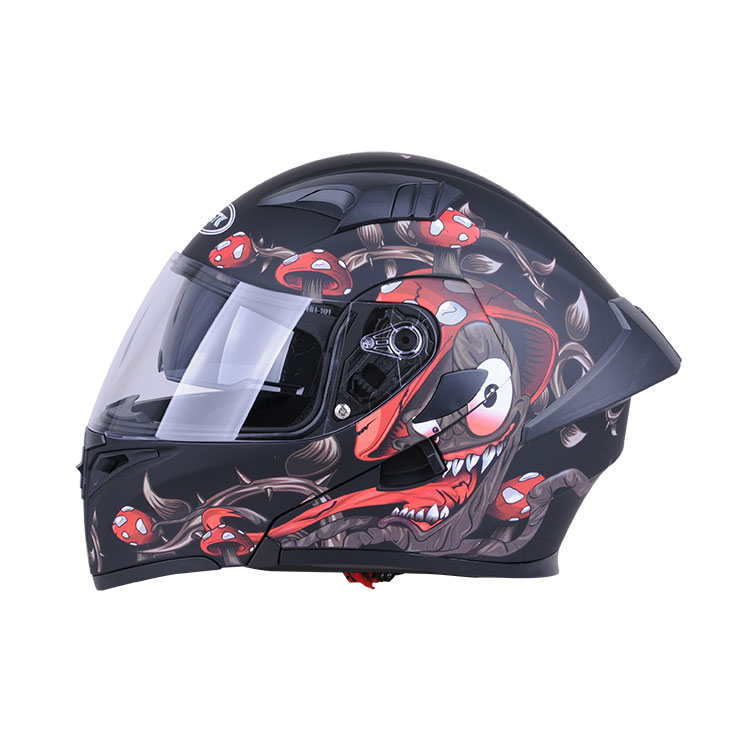- Español
- Português
- русский
- Français
- 日本語
- Deutsch
- tiếng Việt
- Italiano
- Nederlands
- ภาษาไทย
- Polski
- 한국어
- Svenska
- magyar
- Malay
- বাংলা ভাষার
- Dansk
- Suomi
- हिन्दी
- Pilipino
- Türkçe
- Gaeilge
- العربية
- Indonesia
- Norsk
- تمل
- český
- ελληνικά
- український
- Javanese
- فارسی
- தமிழ்
- తెలుగు
- नेपाली
- Burmese
- български
- ລາວ
- Latine
- Қазақша
- Euskal
- Azərbaycan
- Slovenský jazyk
- Македонски
- Lietuvos
- Eesti Keel
- Română
- Slovenski
- मराठी
- Srpski језик
The Main Types and Functions of Motorcycle Helmets
2022-01-20
The main types and functions of motorcycle helmets
There are many types of motorcycle helmets with many different designs to choose from. Therefore, each helmet has its own characteristics and advantages. How to choose a suitable helmet still needs to understand the functions of each helmet.
1. Full helmet, in the event of an accident, the full helmet can minimize the damage to the head, and its wrapping degree is the best among all helmet categories. The advantage is that oncoming wind can be blocked with minimal wind resistance, and external noise is canceled by the foam that wraps the inside of the helmet. However, the disadvantages of full face helmets are that the angle of visibility is not wide compared to their type of helmets, some full face helmets are heavy, prolonged use can cause neck fatigue, etc.
2. Rally helmets have the dual advantages of full-face helmets and off-road helmets. Removable lenses allow for a wider field of vision when off-road. Features a long chin design and longer upper guard to help limit direct frontal impact. The downside is that it's susceptible to noise, and there's a lot of air resistance, especially with the top guard open. Therefore, it is very suitable for the dual needs of rally motorcycles taking into account both long-distance and off-road.
3. Off-road helmets, because the front windshield lenses are not used, so you can get a comfortable vision, you can bring your own glasses to prevent dust from entering. The long cap chin helps protect the user's jaw and teeth well, and the top cap is designed to help block sunlight and block obstacles such as tree branches from entering the eyes when off-road. On the downside, it's designed to interfere with positive air pressure, so it's not suitable for faster speed riding.
4. The biggest difference between the uncovered helmet and the full helmet is that the face can be lifted up from the chin, which can be worn more easily, and you can eat and drink when you take off the helmet, and some can even be disassembled at will to change. A 3/4 helmet. However, its disadvantages and advantages coexist. Because the position of the chin is designed to be detachable, the fixed structure between the chin and the chin locking pin is not as strong as that of a full-face helmet. If there is a problem, it will not be able to safely protect the user's chin.
5. Retro helmet, this kind of 3/4 helmet without goggles is commonly worn by users of retro motorcycles and cruising motorcycles. Because it is more convenient to wear sunglasses, it is more popular with them, and they have a wide field of vision. Convenient and comfortable. The disadvantage is that in the event of an accident, the facial area cannot be effectively protected.
6. Half helmet, the advantages of half helmet are compact design, low production cost, and small size, which is easier to place and store. The disadvantage is that the safety factor is low, and the more common use environment is among people such as small pedals and electric vehicles.

There are many types of motorcycle helmets with many different designs to choose from. Therefore, each helmet has its own characteristics and advantages. How to choose a suitable helmet still needs to understand the functions of each helmet.
1. Full helmet, in the event of an accident, the full helmet can minimize the damage to the head, and its wrapping degree is the best among all helmet categories. The advantage is that oncoming wind can be blocked with minimal wind resistance, and external noise is canceled by the foam that wraps the inside of the helmet. However, the disadvantages of full face helmets are that the angle of visibility is not wide compared to their type of helmets, some full face helmets are heavy, prolonged use can cause neck fatigue, etc.
2. Rally helmets have the dual advantages of full-face helmets and off-road helmets. Removable lenses allow for a wider field of vision when off-road. Features a long chin design and longer upper guard to help limit direct frontal impact. The downside is that it's susceptible to noise, and there's a lot of air resistance, especially with the top guard open. Therefore, it is very suitable for the dual needs of rally motorcycles taking into account both long-distance and off-road.
3. Off-road helmets, because the front windshield lenses are not used, so you can get a comfortable vision, you can bring your own glasses to prevent dust from entering. The long cap chin helps protect the user's jaw and teeth well, and the top cap is designed to help block sunlight and block obstacles such as tree branches from entering the eyes when off-road. On the downside, it's designed to interfere with positive air pressure, so it's not suitable for faster speed riding.
4. The biggest difference between the uncovered helmet and the full helmet is that the face can be lifted up from the chin, which can be worn more easily, and you can eat and drink when you take off the helmet, and some can even be disassembled at will to change. A 3/4 helmet. However, its disadvantages and advantages coexist. Because the position of the chin is designed to be detachable, the fixed structure between the chin and the chin locking pin is not as strong as that of a full-face helmet. If there is a problem, it will not be able to safely protect the user's chin.
5. Retro helmet, this kind of 3/4 helmet without goggles is commonly worn by users of retro motorcycles and cruising motorcycles. Because it is more convenient to wear sunglasses, it is more popular with them, and they have a wide field of vision. Convenient and comfortable. The disadvantage is that in the event of an accident, the facial area cannot be effectively protected.
6. Half helmet, the advantages of half helmet are compact design, low production cost, and small size, which is easier to place and store. The disadvantage is that the safety factor is low, and the more common use environment is among people such as small pedals and electric vehicles.



